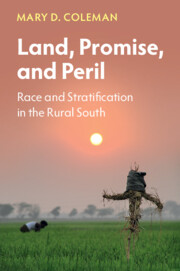Book contents
- Land, Promise, and Peril
- Cambridge Studies in Stratification Economics: Economics and Social Identity
- Land, Promise, and Peril
- Copyright page
- Contents
- Figures
- Tables
- Preface
- Acknowledgments
- Part I The Family in an Intemperate Community, State, and Nation
- Part II Family Interiority and Economic Mobility Pathways
- Part III Pathways toward Upward Economic Mobility
- 13 Beyond Caste in Higher Education
- 14 The War on Poverty and the Poor in Sunflower
- 15 What the Research Tells Us
- 16 Insights and a Valedictory
- Epilogue
- Select Bibliography
- Index
13 - Beyond Caste in Higher Education
The Ayers/Fordice Case and Its Impact
from Part III - Pathways toward Upward Economic Mobility
Published online by Cambridge University Press: 15 April 2023
- Land, Promise, and Peril
- Cambridge Studies in Stratification Economics: Economics and Social Identity
- Land, Promise, and Peril
- Copyright page
- Contents
- Figures
- Tables
- Preface
- Acknowledgments
- Part I The Family in an Intemperate Community, State, and Nation
- Part II Family Interiority and Economic Mobility Pathways
- Part III Pathways toward Upward Economic Mobility
- 13 Beyond Caste in Higher Education
- 14 The War on Poverty and the Poor in Sunflower
- 15 What the Research Tells Us
- 16 Insights and a Valedictory
- Epilogue
- Select Bibliography
- Index
Summary
A century after the Emancipation Proclamation and the 13th, 14th, and 15th amendments, Julian Bond observed in the 1970s that what passes for public education in the South has been a distressing and dehumanizing process for black children. Despite this indisputable fact, the black working rural poor, who cleaned the toilets, picked the cotton, logged the timber, cared for whites’ children, and cooked the meals of the white leisurely class, believed in educating their children. However, segregated public schools, even good ones with value-added teachers, were built sideways, to affirm the present rather than confront public dispossession. Still, they were, for many, places of heterogeneity, populated by blacks of all classes, aspirations, and hues, environments where Lonnie, Matthews, Clementine, and Williams and their children were poised to learn. Schoolmates whose parents were part of the tiny middle class, those whose parents were among the ambitious working class, and the teachers who believed in and challenged them, as best they were able, to orient children’s imaginations toward the future. Some individuals and organizations worked to support these aspirations.
- Type
- Chapter
- Information
- Land, Promise, and PerilRace and Stratification in the Rural South, pp. 253 - 292Publisher: Cambridge University PressPrint publication year: 2023

